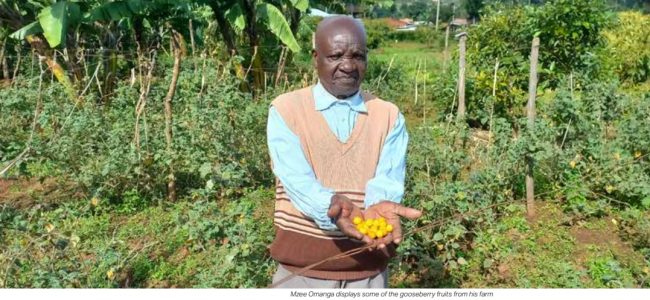
Mzee Omanga, The Old Man Feeding Kisii with Gooseberries
Mzee Elijah Omanga, 81, has decided to take a different trajectory, by engaging in the farming of Gooseberries.
Magena town, which is located in Bomachoge-Borabu constituency, Kisii County, is well known for the cultivation of Indigenous vegetables such as Black Nightshade, cowpeas leaves, and lately its gooseberries on the radar. Most residents here, especially women, are the main growers of these indigenous crops.
As you tour the small town, you will get a glimpse of huge lorries, packed along the town’s main market, waiting to be loaded with the produce so they can transport them to different towns, where they are largely consumed.
However, Mzee Elijah Omanga, 81, has decided to take a different trajectory, by engaging in the farming of Gooseberries. Despite his old age, Mzee Omanga has been practicing farming since his youthful days.
The farmer says that most people do not know that the fruits can be domestically grown and become a source of livelihood, as they grew in the forest in the old days. In the colonial days, Mzee Omanga worked as a chief of the entire Abamachoge clan.
The Hortfresh team visited the old man at his farm in Riomanga village, where he resides, to get a deeper perspective of why he has stuck in the farming of the crop for years.
Apart from enabling him TO educate his 14 children, Mzee Omanga says that one of the reasons why he has enjoyed quite a long life with good health is the consumption of the unique fruit.
Given that his age is quite advanced, he says that he employs people to perform difficult tasks such as tilling the land. However, he does the rest of the work himself, such as planting and tending the plants.
“I was dismissed from my job in the 1970s in very controversial circumstances. One day when I visited my daughter in Kisii town, I saw some gooseberries growing outside her house. I plucked some fruits, which I carried with me home. I planted the seeds from the few fruits I carried. That’s how I started my journey to gooseberry fruit farming,” said Mzee Omanga.

What pushed him to embrace the farming of gooseberries was that every time he traveled to Kisii town, the Indians who owned big shops there always asked their workers on where they could get the rare fruits.
“Given that the fruit’s availability was rare, those who managed to take them to the Indians were paid very handsomely. I saw a gap and an opportunity. That made me start farming the fruit immediately. For sure, the fruit has really uplifted me economically, mostly helping me educate my 14 children,” he adds.
He practices farming on his one-acre piece of land. Mzee Omanga farms the yellow gooseberries, saying that fruit is easier to plant and maintain compared to other crops, given that they do not require frequent weeding.
According to him, anyone who plans to start farming the fruit must get the seeds from ripe gooseberries. The gooseberries are broken and its seeds are put under the sun to dry.
When the seeds are fully dry, they are transferred to a nursery, where they germinate.
After a period of one month, the gooseberries’ seedlings will be ready to be taken to the garden to be planted. Before planting the seedlings, it is important to clear the garden through thorough weeding. After that, planting holes are supposed to be dug half a foot deep, where manure or plant manure can be used.
The width from one plant to another should be one and a half meters because when the gooseberries start to grow, they get a lot of branches and so if you plant them too close, the plants will become a bush and fail to give you abundant harvests.
In order to give the gooseberry plants strength and make them not fall apart during strong winds, Mzee Omanga says it is better to stop them using sticks and wires.
After planting, the gooseberries will begin to bear fruit after three months. As they mature, they will begin to turn from green to yellow.
The sign of a ripe fruit is that the outer skin of the fruit starts to dry. If they start bearing, one can pick the fruit up to two years before the plants get old. Ripe gooseberries can be picked with or without skins and then sent to the market.
If you are going to harvest by removing the skins that cover the fruit, you must have plastic containers to keep it. He uses small net bags, sold in the market. He sells each fruit for Sh1. He has customers from the towns of Kilgoris and Kisii. In a month, Omanga says he earns more than Sh20,000 from the sale of gooseberries.
The fruit does not suffer from many diseases. The main problem he has faced is the destructive birds that eat the fruits when they start to ripen and thus, have to chase them away when they are many.
According to nutritionist Michael Wokabi, gooseberries contain many minerals that are good for the human body. Gooseberries do not contain many calories and their nutrients help to control sugar in the body and protect the heart and brain to ensure that these organs work properly.

